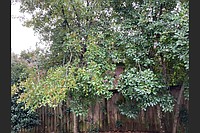Q We have a stand of three 20-year-old Savannah hollies in our backyard. Over the past month or so, the leaves of the one on the left have started turning yellow, and the berries may even be more yellow than its two neighbors on the right. The limbs are drooping, and the tree looks very unhappy. We have read that maybe too much water or too little iron can cause this problem. We welcome your thoughts.
A In looking at the pictures, I wonder whether the yellowing is due to a problem or to a heavy fruit set. It looks like you have a copious amount of fruit — and more on the ones that are yellowing. When a plant produces fruit, it directs energy into the fruit, and sometimes the foliage can suffer. On the flip side, sometimes when a plant is dying, it will set extra fruit to perpetuate life from seeds. I cannot imagine that a watering issue is to blame after 20 years of growth. I would get some Ironite fertilizer or liquid iron and lightly spray the plants with it. See if you can see some green up. If so, it may just be the mother plant is stressed from feeding so many fruits. Let's hope that is the problem. Continue to monitor the plants the next few months and see what happens.
■ ■ ■
Q Help! We have some crape myrtles that were planted last fall and early this spring. They have been diagnosed as being infected with cercospera. We have been told by one person that they won't survive, but another professional disagrees and assures me they will survive. Please give me some guidance. I either must replace them this fall or take a chance on them recovering.
A Cercospera is a fungal leaf-spot disease. Usually, it is not deadly. Heavy infestations can cause the plants to defoliate early, which over time can weaken the plant and lead to more problems. This late in the season, I would not use a fungicide to try to treat them. Rake up all the falling leaves, and continue to do so until the trees are bare. Good sanitation will be important. After all the leaves are off the plant, spray with a dormant oil. Dormant oils don't contain any insecticidal or fungicidal properties, but they smother out any disease spores or overwintering insects. This can help suppress crape myrtle bark scale too. Then, next spring, monitor the trees. I would not start a preventive spray program unless you start seeing this problem each year. If you do see signs of the disease in the spring, then you can use a fungicide. A number of them are labeled for control. I would not call it quits or consider replacing them at this time.
Photo Gallery
In The Garden — October 16, 2021
Photographs to accompany Janet Carson's "In The Garden" column for October 16, 2021.
Q What is this and where can I get more? [The reader sent a photo.] A nice surprise at this time of year.
A You named it — it is a surprise lily (Lycoris radiata). Occasionally you will find the bulbs at a local nursery, but more often you either need to get some from a friend — they are a great pass-along plant — or you can order from a bulb nursery online. The strap-like foliage will appear after they bloom, and it will grow all winter. In mid-spring, the foliage will die down. Then in late September or October, leafless (naked) stems will appear again with these red, spider-like flowers.
■ ■ ■
Q I am attaching some pictures of our Green Giant arborvitae and one of our Emerald Green arborvitaes. We planted the green giants about three years ago and the Emerald Green about one year ago. A couple of weeks ago, we started seeing brown patches on the Emeralds. We thought maybe it was too much sun or heat and/or not enough water. We watered them during the dry stretch and applied a slow-release fertilizer. After a week out of town (last week), we came home to this. We have applied a pesticide (Spectracide Bug Stop) and a broad-spectrum fungicide as a desperation measure. I don't want to lose them, and I don't want to replace them without knowing what happened. Do you have any suggestions?
A I don't recommend spraying with insecticides or fungicides unless an insect or disease has been diagnosed. Unfortunately, I don't think you will have much luck in saving some of them. The all-brown plant is probably a goner. Keep investigating. Do you see any bagworms, splits or cracks or growths on any of the branches or trunk? Arborvitae are not as drought tolerant as many people think. They prefer even moisture. Depending on where you live, rainfall was very spotty from late August through September. They can use vast quantities of water when it is so hot and dry. I also see they are planted in the midst of your lawn — the grass is competing for moisture, too. Mowing and/or using a string trimmer around them too close to the trunk can sometimes girdle the base of an arborvitae. For now, watering is the only thing you can do. Assess new growth next spring and cut out any damaged branches. Unfortunately, needle-type evergreens are not as forgiving as broad-leaf evergreens in sprouting back after damage, but time will tell. Good Luck.
Retired after 38 years with the University of Arkansas Cooperative Extension Service, Janet Carson ranks among Arkansas' best known horticulture experts. Her blog is at arkansasonline.com/planitjanet. Write to her at P.O. Box 2221, Little Rock, AR 72203 or email jcarson@arkansasonline.com

